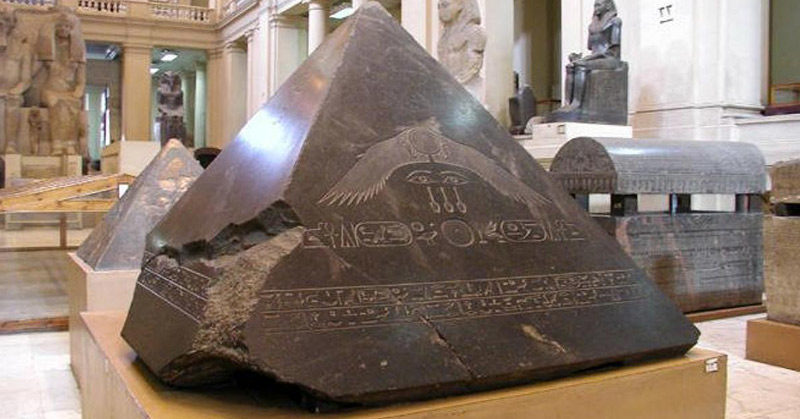The pyramids of Ancient Egypt have fascinated both archaeologists and citizens alike for centuries. The magnificent structures, which have been shrouded in mystery for much of their existence, have been the backdrop for countless books, movies, and television shows, and their mummified inhabitants have inspired stories and legends of ancient Kings coming back from the dead to seek their revenge.
Despite the decades of research that has been poured into them, archaeologists still have many unanswered questions about the pyramids of Egypt. One of these questions zeros in on one small but very important part of the pyramid- the capstone.
Read: Perfectly preserved ancient Roman mosaic floor discovered in Italy
Pyramid Capstones
The pyramid capstone is arguably the most mysterious part of the entire structure. Also called the pyramidion, it is the uppermost piece that was placed on the top of pyramids and obelisks [1].
In Ancient Egypt, the pyramidion was called the benbenet. It was given this name in order to associate the entire structure to the sacred Benben stone. According to the Heliopolitan form of ancient Egyptian religion, Benben was the mound that arose from the primordial waters of Nu, in which the creator god Atom (who was also known as Atom-Ra, then Ra, the Sun God) shaped the world [2].
This makes the Benben one of the most important and sacred parts of the pyramid.
What makes these capstones so mysterious, however, is their distinct absence from so many of the pyramids throughout Egypt, most notably the pyramid of Giza. For this reason there is significant debate as to whether or not early pyramids had one at all.
Despite the apparent importance of the pyramidion, or capstone, the pyramids of Khufu, Khafre, Sneferu, and many others do not have one. Without its capstone, the pyramid is incomplete. This has led to many questions, including what happened to the capstone of the pyramids? Did it ever exist? If so, what was it made of? Was it Gold? Was it destroyed in ancient times? Or was it looted, like many of the pyramids were [1]?
The Black Pyramid
One of the few known capstones in existence is that of the Black Pyramid.
The Black Pyramid was built by Amenemhat III, pharaoh of the twelfth dynasty of ancient Egypt, who ruled from 1860 BC to 1814 BC. Its original name was “Amenemhat is mighty and perfect”, however, the pyramid itself is anything but.
The Pyramid began crumbling almost as soon as it was built and looks nothing like the great pyramids of Giza we can see today. It was made out of dark mudbrick and clay and was built on the unstable ground too close to the Nile, causing it to flood soon after it was finished.
It also lacks the stone framework seen on most other pyramids that help to stabilize the structure. Its unusual shape, then, is likely due to damage caused by bad weather, as well as robbers attempting to steal the treasures held within its walls [3].
The capstone, however, is in remarkably good condition, leading many researchers to believe that the stone may not have been left on top of the pyramid. Hieroglyphics are inscribed on the stone, and they read as follows:
“Son of Ra, Amenemhat, given life forever. King of Upper and Lower Egypt, Nimaatre, given life forever. May the face of the king of Upper and Lower Egypt, Nimaatre, be opened so that he may see the Lord of the Horizon (Horakhty, Horus of the Horizon) when he crosses the sky; may the Lord of the Horizon cause the Son of Ra, Amenemhat, to shine as a god, lord of eternity and indestructible. The Lord of the Horizon has said: ‘I have given the beautiful horizon to He of the Two Ladies (Nebty), Itjijautawy (He who inherited the Two Lands), so that you may unite with the horizon’; the horizon has said that you rest upon it, which pleases me.” [4]
Due to the unstable nature of the Black Pyramid, Amenemhat actually constructed a second pyramid at a higher elevation in which he would be buried. The pyramid was instead used to bury several other royal women [4].
The capstone can currently be viewed at the Egyptian Museum in Cairo.
Keep Reading: There are Ancient Ruins Older Than The Pyramids In Canada
- https://curiosmos.com/unrecorded-mystery-what-happened-to-the-capstones-of-egypts-ancient-pyramids/
- https://www.thevintagenews.com/2016/09/15/mysterious-benben-stone-obelisk-like-stone-symbolic-primeval-mound-creation-heliopolis/
- https://travel2egypt.org/egypt-travel-guide/giza-travel-guide/while-you-are-there/places-to-go/dahshur-necropolis/the-black-pyramid/
- https://auxx.me/intact-pyramid-capstones/

